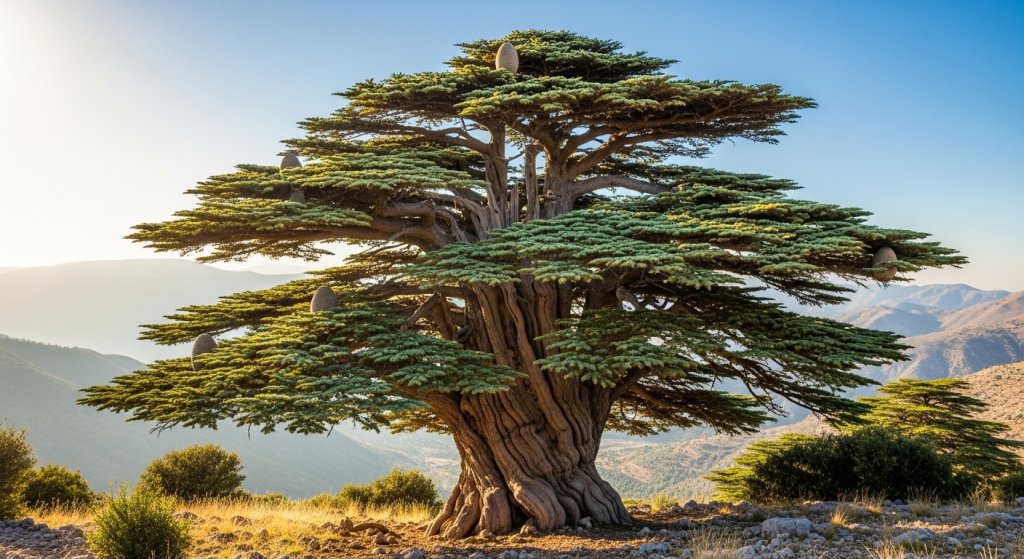The cedar of lebanon is more than just a tree. It is a powerful symbol of history, culture, and resilience. For thousands of years, this majestic tree has stood tall on the mountains of Lebanon. It is deeply rooted in the identity of the nation and its people. The tree is a living connection to an ancient world. It appears in holy texts and was used by some of the most powerful civilizations in history.
This article explores the rich history of the cedar of lebanon. It covers its importance in ancient times, its role in a famous holy tale, and its modern-day significance.
The Cedar of Lebanon: A Holy and Ancient Tree
The cedars of Lebanon hold a special place in religious and historical texts. Their immense size, strength, and longevity made them a symbol of power, nobility, and eternity.
- Biblical Stories & Cedar Symbolism: The Bible mentions the cedar tree over 70 times. King Solomon famously used the prized cedar of lebanon wood to build the First Temple in Jerusalem. He relied on Phoenician craftsmen to cut the trees. They then transported the lumber by sea, a testament to its value and durability. The prophet Isaiah calls the tree the “glory of Lebanon.” Its symbolism deeply ties to righteousness and divine favor.
- Use in Ancient Construction: Beyond temples, ancient civilizations highly sought after the wood. The Phoenicians, legendary seafarers, used its rot-resistant wood to build their mighty ships. The Assyrians, Egyptians, and Babylonians also used the wood for palaces and temples. This made the use in ancient construction of cedar a clear sign of wealth and prestige.
The Cedar’s Surprising Role in Mummification
While Lebanon and Egypt are in different regions, the cedar of lebanon was a vital part of ancient Egyptian culture and their most important rituals. This is a surprising but fascinating connection.
- Mummification of Ancient Egyptians: The ancient Egyptians used cedar oil and resin in their embalming process. The oil’s natural antiseptic and antifungal properties were crucial for preserving the body for its journey to the afterlife. They used it to anoint the body. Its pleasant fragrance was associated with divinity and purity.
- Coffin Construction: Craftsmen also created the most luxurious coffins for pharaohs and the elite from imported cedar of lebanon wood. The wood’s pleasant scent and durability were perfect for protecting the body for eternity.
The Cedar’s Modern-Day Status: Symbolism and Conservation
Today, the cedar is more than a historical icon. It is a living symbol of Lebanon’s national identity and its fight for survival.
- A National Symbol: The cedar tree is the central symbol on the country’s flag. It represents peace, holiness, and the resilience of the Lebanese people in the face of adversity. This deep cultural connection makes the tree a powerful national emblem.
- The Oldest Cedar Tree in Lebanon: We find the oldest known living cedars in protected reserves. These include the Cedars of God forest in Bsharri and the Shouf Cedar Nature Reserve. Some of these ancient giants can reach up to 40 meters in height. They are estimated to be over 3,000 years old. These protected forests serve as a vital link to Lebanon’s past.
- Conservation Status and Problems: Sadly, due to thousands of years of over-harvesting, the IUCN now lists the cedar of lebanon as a vulnerable species. They face new threats from climate change. These include reduced snowfall and more frequent insect outbreaks.
Growing and Caring for a Lebanese Cedar
For those interested in the natural aspect of this magnificent tree, here are a few details about its growth and care.
- Types of Lebanese Cedar: The scientific name for this tree is Cedrus libani. While there are other varieties of true cedars, like the Atlas Cedar and the Deodar Cedar, the Lebanese Cedar is distinct.
- Lebanese Cedar Care: The trees are very resilient. They can grow in difficult, rocky environments on mountain slopes. For healthy growth, they require full sun and well-drained soil. They can tolerate a variety of soil types. However, they are particularly susceptible to root rot in mucky or poorly drained soil.
- Common Problems with Lebanese Cedar: While a tough tree, root rot can affect it. It is also susceptible to certain insect pests. These include aphids and the cedar web-spinning sawfly.
Conclusion
The cedars of Lebanon continue to inspire people around the world. They are a gateway to understanding Lebanon’s rich culture and its ancient history. By exploring their deep roots in everything from sacred tales to ancient mummification, you gain a unique perspective on this remarkable tree and the enduring nation it represents.
To continue your journey into Arabic language and culture, consider using a comprehensive learning platform. The Kaleela app is a great tool for learners, offering courses in both Modern Standard Arabic (MSA) and various dialects. It’s an excellent way to continue your studies and learn more about the fascinating stories and history of the Arab world. Download the Kaleela app today and start your next lesson!



